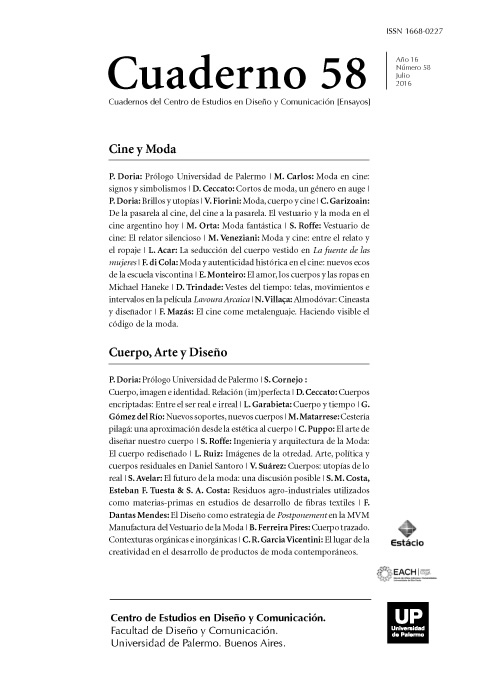Cestería pilagá: una aproximación desde la estética al cuerpo
Abstract
This article is part of the studies on aesthetic and anthropology. In this work the pilagá basketry production is approached from two different but complementary areas. On one hand, we analyze how the female body is one of the instruments of this basketry production, as it is exposed, articulated and molded during the process of making handicrafts. Also this body is also subject and is exposed to appreciative dilemmas concerning what is supposed to be a woman artisan and what their qualities are. On the other hand, the article explores the production and basketry patterns and designs that the market demand as authentic, focusing in various ways on the aesthetic criteria and meanings of craft regarding their production. From this network of practices and meanings, it becomes posible the reflection about aesthetics and the linkages with bodies and objects in pilagá basketry and to make, after this study, some contributions to the question of aesthetics and design from an integrative approach of different crossing processes.
References
Arenas, P. (2003). Etnografía y Alimentación entre los Toba-Ñachilamole#ek y Wichí-Lhuku´tas del Chaco Central (Argentina). Buenos Aires: Ed. Pastor Arenas.
Ascheri, P. (2012) Entre Buda y Rodin. Traducciones culturales en los cuerpos de la danza butoh argentina. En Citro, S. y P. Ascheri. (comps) Cuerpos en Movimiento. Antropología de y desde las danzas. (p. 265-290). Buenos Aires: Editorial Biblios.
Citro, S. (2010). La Antropología del cuerpo y los cuerpos en-el-mundo. Indicios para una genealogía (in)disciplinar. En Citro, S (comp.) Cuerpos Plurales. Antropología de y desde los cuerpos. (p.17-52). Buenos Aires: Editorial Biblio.
Coote, J. (1992). ‘Marvels of Everyday Vision´: The Anthropology of Aesthetics and the Cattle Keeping Nilotes. En Coote J. y A. Shelton (comps). Anthropology, Art and Aesthetics (Oxford Studies in the anthropology of cultural forms). (p. 245-73). Oxford: Clarendon Press.
Eagleton, T. (2006). La estética como ideología. Madrid: Trotta.
Encuesta Complementaria de Pueblos Indígenas (ECPI) 2004-2005. Complementaria del Censo Nacional de Población, Hogares y Viviendas 2001. Instituto Nacional de Estadística y Censo (INDEC). Disponible en: www.indec.gov.ar. Ministerio de Economía y Producción.
García, M. A. y A. M. Spadafora (2010). Antropología de las políticas de integración estética entre aborígenes y blancos. Prácticas musicales y representaciones abstractas y figurativas de los pilagá e ishir del Gran Chaco. Proyecto PIP-CONICET Nº 01415. Consejo Nacional de Investigaciones Científicas y Técnicas (CONICET). Manuscrito no publicado.
Ingold, T. (2001). El Forrajero óptimo y el hombre económico. En: P. Descola y G. Pálsson (comps.) Naturaleza y Sociedad. Perspectivas antropológicas. (p. 37-60). México: Siglo XXI.
Maquet, J. (1999). La experiencia estética. Madrid: Celeste Ediciones.
Matarrese, M. (2013). Antropología y Estética: el caso de la cestería pilagá. PROA- Revista de Antropología y Arte. Programa de Pós-Graduação em Antropologia Social do IFCHUNICAMP. Brasil. Disponible en: http://www.revistaproa.com.br/04/?page_id=354(2012). Notas acerca de las dimensiones estéticas de la política artesanal de la Provincia de Formosa: el caso de los pilagá. Revista Claroscuro N° 11, 90-107. Revista del Centro de Estudios sobre Diversidad Cultural, Universidad Nacional de Rosario.
(2011). Disputas y negociaciones en torno al territorio pilagá (provincia de Formosa). Tesis Doctoral. Universidad de Buenos Aires, Facultad de Filosofía y Letras. Manuscrito no publicado.
Myers, F. (2005). ‘Primitivism’, anthropology, and the category of ‘primitive art’. En: C. Tilley, S. Kuechler, M. Rowlands, W. Keane y P. Spyer (comps.) Handbook of Material Culture. (p. 267-284). London: Sage Press.
Morphy, H. Morphy, H. (1992). From Dull to Brillant: the Aesthetics of Spitirual Power among the Yolngu. En: Coote, J. and A. Shelton (comps.) Anthropology, Art, and Aesthetics. (p. 181-208). Oxford: Oxford University Press.
(1991). Ancestral connections: Art and an aboriginal system of knowledge. Chicago: Univeristy of Chicago Press.
Perez De Micou, C. (2003). Pautas descriptivas para el análisis de cestería arqueológica. Programa de estudio, valoración y preservación de textiles argentinos. La tecnología cestera como tecnología textil. Instituto Nacional de Antropología y Pensamiento Latinoamericano. Consultado el 23/08/2010. Disponible en: http://www.inapl.gov.ar/invest/patrim_textil_02.html.
Pitla´Lasepi Lo´Onanagak. Cestería Pilagá. (2004). Artesanías en la Argentina. Desarrollo Sustentable y Fomento de la Diversidad Cultural. Federación de Comunidades Pilagá. Buenos Aires: Secretaría de Cultura de la Nación.
Sharman, R. (1997). The Anthropology of Aesthetics: A cross-cultural approach. Journal of the anthropological society of Oxford, 28 (2), 177-192.
Spadafora, A. M. y M. Matarrese (2010). Artesanía aborigen: cestería y diseños figurativos entre los pilagá –Formosa, Argentina. Revista Espacio.
Los autores/as que publiquen en esta revista ceden los derechos de autor y de publicación a "Cuadernos del Centro de Estudios de Diseño y Comunicación", Aceptando el registro de su trabajo bajo una licencia de atribución de Creative Commons, que permite a terceros utilizar lo publicado siempre que de el crédito pertinente a los autores y a esta revista.


